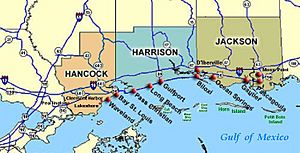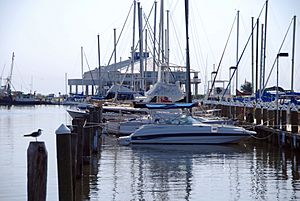Pass Christian, Mississippi facts for kids
Quick facts for kids
Pass Christian, Mississippi
|
|
|---|---|
| City of Pass Christian | |
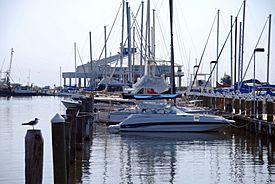
Pass Christian Harbor in August 2008
|
|
| Nickname(s):
The Pass
|
|
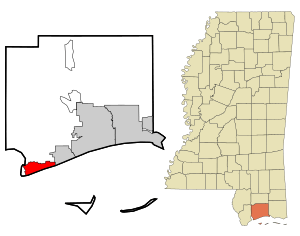
Location within Harrison County and Mississippi
|
|
| Country | |
| State | |
| County | Harrison |
| Chartered (town) | 1848 |
| Government | |
| • Type | Mayor-Council |
| Area | |
| • Total | 15.27 sq mi (39.54 km2) |
| • Land | 8.24 sq mi (21.33 km2) |
| • Water | 7.03 sq mi (18.21 km2) |
| Elevation | 13 ft (4 m) |
| Population
(2010)
|
|
| • Total | 4,613 |
| • Estimate
(2019)
|
6,307 |
| • Density | 765.78/sq mi (295.68/km2) |
| Time zone | UTC−6 (Central (CST)) |
| • Summer (DST) | UTC−5 (CDT) |
| ZIP code |
39571
|
| Area code(s) | 228 |
| FIPS code | 28-55400 |
| GNIS feature ID | 0675482 |
Pass Christian, nicknamed The Pass, is a city in Harrison County, Mississippi, United States. It is part of the Gulfport–Biloxi Metropolitan Statistical Area. The population was 6,307 at the 2019 census.
History
Pre-history
The exact date when Native Americans first arrived in the Gulf Coast area is not known, but artifacts have been found suggesting that humans have inhabited the area for many thousands of years.
Indian mounds can be found throughout the Gulf coast region of southern Mississippi, but many have been destroyed by artifact hunters, farmers, developers, and flooding. A 1768 English map shows one large mound existed on the shore near to Market Street. Others existed at Bayou Portage and the Shelly Plantation on the shore north of the Bay of St. Louis near DeLisle. The mounds and middens in the area containing arrowheads, pottery, and human skeletons were pilfered by amateur archaeologists over the years and many of the items recovered are in private collections. At the border of Pass Christian and Long Beach near White Harbor Road meets Hwy. 90 there once existed an Indian village, whose inhabitants were referred to by locals as "The Pitcher Point Indians". The approximate location of the Indian Village is just a few hundred yards east of White Harbor Road. There are no ruins at this location but the beach in this area has produced many arrowheads and pottery shards over the years.
Spanish explorers
It is likely that Pitcher Point is the location where survivors of the 1528 Álvar Núñez Cabeza de Vaca Narváez expedition landed naked and starving among a people called the Carnones. This story was told to DeVaca by friendly Indians who stated that, “the natives had killed the Spanish who were so feeble that they could not defend themselves.”
French explorers
Pass Christian was discovered by French-Canadian explorers in 1699, shortly after the first French colony was established in Biloxi. In June 1699, while sounding the channel at the Pass Christian peninsula, the French named that channel Passe aux Huîtres for the many oysters they found there. Pass Christian was named for a nearby deepwater pass, which in turn was named for Nicholas Christian L'Adnier, who lived on nearby Cat Island beginning in 1746.
They remained on Ile aux Vaisseaux the following day due to bad weather. On the 13th Iberville and his brother Bienville with a party of thirteen men went ashore, sailing due north from the west end of the island. Their landing would have been somewhere between present-day Beauvoir and Edgewater.
The following morning they explored eastward along the beach, following footprints in the sand until they caught sight of three Indians in a canoe leaving Deer Island. Iberville pursued them across Biloxi Bay, catching up just as they reached shore at Ocean Springs. The younger natives fled into the woods leaving an old and dying man. The Frenchmen made him a bed of straw and built him a fire before withdrawing to make a camp for themselves. Unfortunately, the grasses around him soon caught fire and though the fires were extinguished, the old man died half an hour later.
Iberville’s hunters captured an old woman in the woods and heaped gifts upon her to take to her people. The first diplomatic contact with the native people had been accomplished and the Indians told them of the great river to the west.
On February 27 Iberville set out “in wind and drizzle” with Bienville, M. Sauvolle and about 48 men to visit the Mississippi River. They spent the night near the south end of the later named Bay of Saint Louis and the following day traversed the Breton Sound in fog and rain which continued through the following day. On March 2, running before a storm, they located and entered the mouth of the Mississippi and traveled up stream making contact with various tribes until on March 16 they came upon a decorated pole which marked the boundary between the Houmas and the Bayagoulas tribes. They called the place Red Stick or “Baton Rouge”. On the return trip, Iberville discovered the proof he sought in the form of letter written by Henri de Tonti to La Salle fourteen years earlier. The letter had been left with the chief of the Mongoulachas who bartered it to Iberville for a few hatchets and knives.
Iberville shortly thereafter divided his party into two groups. Bienville returned by the mouth of the Mississippi while Iberville explored the area of Pass Manschac, lakes Maurepas and Pontchartrain and returned to the open water by the Rigolets.
When Iberville departed from his ships on April 27, he instructed them to return to France if he had not returned within one month. On March 30 he camped near the mouth of the Bay of Saint Louis where he built a large fire to signal his return.
The following morning he recognized Cat island, and shortly thereafter reached his ships. About an hour later Bienville and his party arrived.
The Widow Asmard
In 1781 all of Pass Christian peninsula was owned by Julia de la Brosse (Widow Asmard). Upon her death in 1799, Widow Asmard deeded 800 arpents – the entire downtown Pass Christian – to Charles Asmar, a free person of color, who upon his death left the property to his heirs. Pass Christian was officially chartered as a town in 1848.
Battle of 1814
On the night of December 12, 1814, more than 1000 British troops and 42 barges en route to New Orleans moved through the pass between Ship and Cat Islands and sailed westward along the Mississippi coast, passing just offshore of Pass Christian. They were closely watched by Lt. Thomas ap Catesby Jones, commanding the seven American boats standing off Malheureux Island as the British proceeded to anchor off Henderson’s Point (western tip of Pass Christian) the night of the 13th of December. He dispatched the tender, Sea Horse, under the command of Sailing Master William Johnson into the Bay of Saint Louis to assist in the removal of the public stores lest they fall to the British. He then sent the ship, Alligator to Chalmette to warn General Andrew Jackson of the British approach.
Word of the British fleet’s arrival spread throughout the county and a large crowd gathered at sunrise on the 14th, along the bluff to watch the fleet passing. Three British boats were dispatched to capture the Sea Horse as it endeavored to load munitions below the bluff at Ulman Avenue. Among the crowd was an elderly lady on crutches, a Miss Claiborne, who was visiting from Natchez. About 2 p.m., on observing the impending attack, she is quoted as saying “Will no one fire a shot in defense of our country” whereupon it is said that she took Mayor Toulme’s cigar and lighted one of the cannon. The ball sailed past the Seahorse and landed close to the approaching British. Assuming that he had fire cover from shore, Capt. Johnson seized the initiative and attacked the British fleet. He had a 6-pounder (canon) on his deck and after half an hour of intense barrage the British retreated. Four more barges joined the first three and the seven renewed the attack. Although Capt. Johnson’s defense was gallant, superior numbers forced him to blow up the little schooner rather than surrender her.
The rest of the American fleet in the Mississippi Sound, consisting of four barges, was anchored in the westerly current between Malheureux Island and Point Clear. On the morning of the 15th, the British rowed their boats into the current until they were about two miles away where they anchored to take tea (breakfast) and rest before attacking. About 10:30 they closed on the brave little fleet under the command of Lt. Thomas ap Catesby Jones.
By 12:40 the battle was over. Six Americans were dead and 35 were wounded. The British suffered 17 dead and 77 wounded. The greater significance of this battle and the greater loss to the British was the passage of time allowing General Andrew Jackson to gather more troops and to complete fortifications for the defense at Chalmette where victory over the British was achieved on January 7.
The British were so certain of victory that they brought civil servants to assume governing the areas they expected to conquer with them, as well as wives and children who were waiting on the Mississippi Coast islands. However, the great victory for the Americans was rendered inconsequential because the peace treaty had already been signed and word had not reached the Coast.
Mississippi became a state in December, 1817 and the first act of the Mississippi legislature was to incorporate the city of Bay Saint Louis (directly across the bay from Pass Christian) to become the capital of the state. The incorporation was completed at the morning session but at the afternoon session, the representative from Rankin County changed his vote and Natchez was designated capital instead. It remained the capital for two years before the capital was moved to Jackson where it remains.
Civil War
The town was a famous resort prior to the American Civil War. It was a favorite location for the beach and summer homes of the wealthy of New Orleans, who built a row of historic mansions along the shoreline, where Scenic Drive was one of the country's notable historic districts. The Southern Yacht Club, established in 1849, was the first yacht club in the South and the second in the United States, and was originally located in Pass Christian before moving to New Orleans in 1857. The Pass Christian Yacht Club was itself founded in the mid 20th century.
During the Civil War, the Battle of Pass Christian occurred when the USS Massachusetts (1860) began shelling the town. The 3rd Mississippi Regiment, which was stationed in Pass Christian, had marched toward Biloxi expecting a Union landing there, leaving Pass Christian completely unprotected. A housewife dashed to her upper floor balcony and waved a white bed sheet, the flag of surrender, and the bombardment ceased. Union soldiers plundered the town before withdrawing, there being little of value, including food, for them to confiscate. This skirmish became known as the Bedsheet Surrender.
Pass Christian flag
On September 4, 1861, 69 men, including Captain Ashbel Green were mustered into military service. They made up the Dahlgren Guards Company, which was part of the Third Mississippi Infantry "C" Regiment, commanded by Col. John Deason. The Pass Christian Dahlgren Guards was headed by Lt. Col. Thomas A. Mellon during their encampment at Camp Tugville, which was located two miles northeast of the Pass near the intersection of White Rock Road and Pass Road.
In the early months of 1862, the women of the Pass raised their spirits by creating a flag that represented their love for their men, devotion for their sovereign state, and dedication to the war effort. The flag they created, The Pass Christian Flag, was an adaptation of the official flag of the Sovereign Republic of Mississippi.
Hurricanes and disaster management
Hurricane Camille
Pass Christian was in the path of two of the most intense hurricanes ever to hit the United States--Hurricane Camille on August 17, 1969, and Hurricane Katrina on August 29, 2005. Each hurricane caused the near total destruction of the city. Hurricane Camille, the 2nd strongest hurricane of the 20th century, was declared a hurricane (meaning it had sustained wind speeds of 74 m.p.h.) on Friday, August 15, 1969. By the time it smashed into the Mississippi Gulf Coast at Pass Christian, Mississippi two days later on Sunday, August 17, it had sustained winds of 190 m.p.h. with gusts in the 210 – 220 m.p.h. range. It also had the 2nd lowest barometric pressure ever recorded [909 millibars (26.85)]. Raindrops hit with the force of bullets, and waves off the Gulf Coast crested between twenty-two and twenty-eight feet above normal tide range. Camille was only the 2nd hurricane on record to reach Category 5 at the time of landfall, as well as being the 2nd most intense hurricane at the time of landfall. The 1935 Labor Day hurricane was the first Category 5 hurricane as well as the strongest and most intense hurricane ever to make landfall in the United States in recorded history.
Hurricane Camille destroyed the Richelieu Apartments killing eight people who had chosen to ride the storm out. The Richelieu Apartments faced the Gulf of Mexico and was less than 250 feet away from the surf on the beach. Early Sunday, August 17, the storm was southeast of New Orleans by 200 miles. A Hurricane Warning was then announced for the entire Mississippi Coast. Evacuation was advised but some of the occupants of the Richelieu apartments ignored the warning. At 10:15 p.m. on August 17, 1969 the front wall of the storm came ashore. The Richelieu Apartments were totally destroyed; all that remained were the foundation and the shell of the in-ground swimming pool, the force of the water pounded the concrete block construction until it completely destroyed the building. The hurricane party depicted in "Hurricane", a 74 min TV Movie featuring some notable stars includes original footage of Camille.
Hurricane Katrina
On August 29, 2005, Pass Christian was almost completely destroyed by Hurricane Katrina. Of the approximately 8,000 homes in Pass Christian, all but 500 were damaged or destroyed. In spite of the fact that the beachfront Scenic Drive follows the crest of a small bluff, affording it some elevation, most of the historic mansions along the road were severely damaged, and many were completely destroyed, including the superbly restored Greek Revival mansion "Union Quarters" described in the National Register of Historic Places as having been built in 1855. A cast iron fence fronted the property enclosing a Magnolia Historical Marker which was dedicated in 1960. It read, "Union officers were temporarily quartered here during the invasion of Pass Christian."
Hurricane Katrina totally destroyed the local public library. It was rebuilt. Thirteen members of the city's police department retreated to the library after the police station became unsafe and water from the Gulf of Mexico began to pour in.
The library was immediately north of City Hall across a small parking lot but was at a lower elevation. When the water crested the elevation of City Hall, the police cars in the parking lot began to float and were carried around the parking lot by the current. One car struck the south side doors, causing them to implode, and the Gulf of Mexico driven by Katrina's powerful winds rushed into the building. With no way to fight against the current they were trapped inside a concrete box that was rapidly filling with water. Knowing that they had to escape they attempted to shoot the glass out of the north side of the building. This was unsuccessful, as the bullets ricocheted off the glass. The laminated glass proved impervious to the .45 caliber rounds of the police-issue handguns. The force of the water entering the building after the southern wall was destroyed by the car was far too strong to swim against. The only way out was with the current. Police Chief John Dubbisson swam to the rear doors that had to be opened where he successfully touched the push bar. He then grabbed a railing before the storm surge could carry him off. All that were inside the library made it outside and rode out the rest of the storm on the roof.
The storm surge from Hurricane Katrina that hit Pass Christian was estimated at 8.5 m (27.8 ft), which is the US record high, leveling Pass Christian up to half a mile inland from the shore; estimation of highest storm surges was complicated because high-water markers were also destroyed. Highway 90 along the beach was damaged, and the bridge over the Bay of St. Louis was thrown completely apart, not being reopened until a new bridge was partially completed in May 2007. (Connection was temporarily replaced by a ferry service.) Sewage contamination rendered the local water supply unusable, as some samples tested positive for more than 250 bacteria and parasites. By late September 2005, access was restricted south of the railroad tracks (about four blocks inland) without proper credentials, as crews continued to search for victims and clear debris. In early 2007, although rebuilding was underway in much of the city, a large portion of empty, deserted homes and other structures remain. Many residents were still living in FEMA trailers, and out-of-state volunteers were still needed for the rebuilding effort.
Geography
According to the United States Census Bureau, the city has a total area of 15.3 square miles (40 km2), of which 8.4 square miles (22 km2) is land and 6.9 square miles (18 km2) (44.97%) is water.
Geographically, the town of Pass Christian located on the Mississippi Sound, and is situated on a peninsula, with water on three sides: the Gulf of Mexico to the south, the Bay of St. Louis to the west and a long stretch of bayou to the north.
The unincorporated area north of the bayou, known as DeLisle (pronounced "duh LILL" or "duh LEEL"), shares a zip code with Pass Christian, but is not within the city limits. DeLisle was formerly known as Wolf Town or Wolftown.
Pass Christian harbor
The Municipal Harbor was formalized in 1956 with the creation of a Harbor Commission. In 1958, an 11-foot high, 350-foot long, concrete, breakwater wall was constructed in the sound by the T.L. James Company. There are only two such concrete harbor walls in the world, with the other in Japan. Almost 1000 linear feet of public fishing is permitted on the two breakwalls. The harbor consists of seven piers, four assigned for pleasure craft and three for commercial vessels. Before it was destroyed by waves from Hurricane Katrina there were 346 slips ranging in berth sizes from 31-feet to 84-feet, in addition to a skiff-pier providing 20 tie-ups. Water, electricity, showers, restrooms, and a bait and fuel station and a vessel pump-out station were available, all overseen from the two-story Harbor Master office.
Oyster Reefs
Pass Christian possessed some of the finest oyster reefs in the world, which have served to anchor Pass Christian’s economy. The oyster reefs that lie just offshore are among the largest on the Mississippi Gulf Coast. The Pass Christian group of Oyster Reefs have been documented on maps since D'Iberville and Bienville chartered these waters in 1699. Early French maps of the area refer to the reefs and batures as Passe aux Huîtres (Oyster Pass). There are nine reefs comprising an area of about twenty square miles. Further west are the Henderson Point and Calico reefs which are one to two miles south of Henderson Point.
Demographics
| Historical population | |||
|---|---|---|---|
| Census | Pop. | %± | |
| 1850 | 790 | — | |
| 1870 | 1,951 | — | |
| 1880 | 1,410 | −27.7% | |
| 1890 | 1,705 | 20.9% | |
| 1900 | 2,028 | 18.9% | |
| 1910 | 2,458 | 21.2% | |
| 1920 | 2,357 | −4.1% | |
| 1930 | 3,004 | 27.5% | |
| 1940 | 3,338 | 11.1% | |
| 1950 | 3,383 | 1.3% | |
| 1960 | 3,881 | 14.7% | |
| 1970 | 2,979 | −23.2% | |
| 1980 | 5,014 | 68.3% | |
| 1990 | 5,557 | 10.8% | |
| 2000 | 6,579 | 18.4% | |
| 2010 | 4,613 | −29.9% | |
| 2019 (est.) | 6,307 | 36.7% | |
| U.S. Decennial Census | |||
2020 census
| Race | Num. | Perc. |
|---|---|---|
| White (non-Hispanic) | 3,520 | 61.91% |
| Black or African American (non-Hispanic) | 1,420 | 24.97% |
| Native American | 20 | 0.35% |
| Asian | 175 | 3.08% |
| Pacific Islander | 6 | 0.11% |
| Other/Mixed | 297 | 5.22% |
| Hispanic or Latino | 248 | 4.36% |
As of the 2020 United States census, there were 5,686 people, 2,163 households, and 1,574 families residing in the city.
Tourism
Middlegate Japanese Gardens
Between 1923 and 1929 New Orleans residents Rudolf Hecht and Lynne Watkins Hecht developed Middlegate Japanese Gardens at their summer home in Pass Christian, Mississippi. The Hechts built Middlegate Japanese gardens to perpetuate their pleasant memories of their travels in Japan. The gardens are listed on the National Register of Historic Places. Since 1923 when the Hechts established them, Middlegate Japanese Gardens have been private, residential gardens.
Sherman Castle
James M. Sherman, at age 67, began construction of Sherman Castle. Designed and built of solid cement, the steel-reinforced castle located at 1012 West Beach, Highway 90 has withstood many hurricanes. At the time of his death, Sherman had completed most of the structure with walls that are nine inches thick. Much of the structure was first laid out in molds that were shaped and poured with concrete to erect the castle piece by piece. The theme of the Castle, "God is my Sculptor" is located on a plaque within the castle.
Economy
Manufacturing
The Du Pont White Pigment and Mineral Products Plant – now known as the Chemours DeLisle Plant – is located just south of I-10 in DeLisle. The plant is the 2nd largest producer of titanium dioxide in the world and has been in operation since 1979. The town of Pass Christian is near the plant, directly across the Bay of St. Louis. Some community members also expressed concerns that chemical releases, as reported on EPA's Toxic Release Inventory, from the DuPont plant could have contaminated the community's water and air. DuPont DeLisle's titanium dioxide plant reported the third highest amount of dioxin-like compounds in EPA's Toxic Release Inventory (TRI). In 2005, the Hurricane Katrina storm surge flooded significant portions of the plant. Unlike other aquatic organisms, blue crabs do not have the ability to metabolize quickly certain dioxin-like compounds Polychlorinated dibenzofurans that predominate in the coke and ore solids waste stream of the plant.
Seafood processing
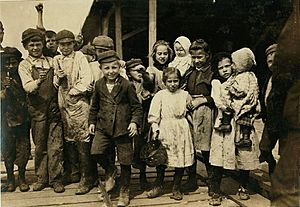
Seafood production in the region has been severely impacted by large scale fish die-offs. The Deepwater Horizon oil spill, which occurred in the spring and summer of 2010—along with the presence of toxic sediments stirred up by Hurricane Katrina and record amounts of fresh water diverted into the Bonnet Carre Spillway in Louisiana—have brought seafood production to a standstill. Offshore oyster beds were hit especially hard. Field crews have reported a 50 percent to 65 percent mortality rate in some areas. An even greater mortality rate of 90 percent to 95 percent has been seen in other oyster beds. According to research from The Nature Conservancy, “roughly 13 years ago, Mississippi was harvesting nearly 500,000 sacks of oysters annually ....” Today, those numbers have fallen as low as 3,500 sacks annually.
Education
The Pass Christian School District operates the schools in the city, and in the inland, unincorporated areas around and to the north of DeLisle. The district operates one early childhood/pre-K facility (University of Southern Mississippi Child Development Center), two elementary schools (DeLisle Elementary & Pass Christian Elementary), one middle school (Pass Christian Middle School) and one high school (Pass Christian High School).
Pass Christian High School was recognized as a National Blue Ribbon School in 2005; Pass Christian Middle School in 2012; and DeLisle Elementary in 2013.
The parochial elementary and middle school of St. Paul's Roman Catholic church was destroyed by Katrina, and the school was merged with the neighboring Long Beach parochial school to form St. Vincent de Paul School. Coast Episcopal High School is a parochial high school in Pass Christian.
Notable people
- Bryan Austin, country music artist
- Phelan Beale, original owner of Grey Gardens
- Clyde F. Bel, Jr., businessman from New Orleans and state representative for Orleans Parish, 1964–1972 and 1975–1980; spent much of his later life in Pass Christian
- Edward Price Bell, Chicago journalist
- Carolyn Crawford, member of the Mississippi House of Representatives
- Scottie Cuevas, former member of the Mississippi State Senate
- Deborah Jeanne Dawkins, former member of the Mississippi State Senate
- Walter Gordon, veteran of World War II Easy Company, as portrayed in the miniseries Band of Brothers
- Lawrence Guyot, civil rights activist
- Captain John Handy, jazz musician
- John Henderson, member of the U.S. Senate from 1839 to 1845
- Doyle Overton Hickey, office in the United States Army who retired to Pass Christian
- Jimmy Johnson, cartoonist and creator of the syndicated newspaper comic strip Arlo and Janis
- Jeanette Kimball, jazz pianist
- Gene Lang (American football), former NFL runningback
- Margaret Loesch, television executive and producer, formerly founding CEO of Fox Kids Networks and the US Hallmark Channel, currently CEO of The Hub, a TV network
- Cory McGee, professional middle distance runner, 2020 Olympian
- Tig Notaro, stand-up comic, born in Jackson, Mississippi but raised in Pass Christian until kindergarten
- Oliver Randolph, African American lawyer and politician
- Robin Roberts, ABC News' Good Morning America anchor
- Jesmyn Ward, novelist, winner of the 2011 National Book Award for Fiction; born in DeLisle
- Larry Yarborough, member of the North Carolina House of Representatives
See also
 In Spanish: Pass Christian para niños
In Spanish: Pass Christian para niños



